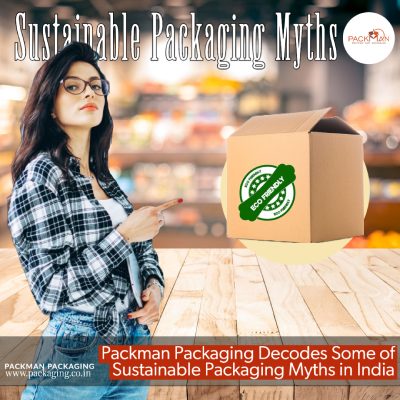Sustainable packaging is crucial in today’s industry, addressing environmental concerns and waste reduction. It offers eco-friendly alternatives like bioplastics, recycled paper, compostable materials, and even edible packaging. These innovative materials prioritize attributes like biodegradability, recyclability, and reduced carbon footprint. By embracing sustainable packaging, we can ensure a greener future and preserve resources for future generations.
However, along with the growing interest in eco-friendly packaging solutions, various myths, and misconceptions have emerged. In this article, Packman Packaging India’s leading manufacturer of corrugated boxes will debunk some of the most common sustainable packaging myths, allowing you to make informed choices that align with your environmental values.
1. All Plastic Packaging is Harmful
While it is true that single-use plastics pose significant environmental challenges, not all plastic packaging is inherently harmful. Plastic materials can be made from recycled content, and innovative solutions such as plant-based bioplastics offer renewable alternatives. These materials, used in vital sectors like food, healthcare, and pharmaceuticals, can minimize food waste and extend product shelf life, benefiting the environment. It is essential to prioritize recycling, reusing, and reducing plastic consumption to mitigate its negative impact.
2. Sustainable Packaging is not affordable
One of the most prevalent myths surrounding sustainable packaging is the assumption that it always comes with a higher price tag. While some sustainable materials may have higher upfront costs, they often offer long-term benefits such as reduced transportation costs and improved brand reputation, which can outweigh the initial investment. For example, recyclable and biodegradable materials can reduce waste management expenses.
Sustainable packaging focuses on using minimal materials, resulting in efficient and cost-effective designs. Additionally, choosing sea freight over air freight reduces both carbon emissions and expenses, although transit times may be longer. Combining air and sea freight through smart planning can yield optimal results.
3. Sustainable Packaging Compromises Product Quality
A common misconception is that choosing sustainable packaging means sacrificing product quality. However, advancements in packaging technology have led to the development of eco-friendly materials that not only safeguard the product but also preserve its quality and integrity. Recyclable fluting, known as corrugated cardboard, offers strength and durability without the need for thicker materials.
Alternative padding options like wood wool, corrugate shrouding, or compostable packing peanuts can be used in mailer boxes. Paper-based honeycomb mailer bags with built-in kraft paper padding or waterproof recycled mailer bags offer durability and recyclability.
4. Sustainability is not only about Recyclability
Sustainable packaging involves more than just recyclability. Considering the entire life cycle of a product is crucial. Glass, for example, can be recycled indefinitely, but its production is resource-intensive and its weight leads to higher transportation emissions. When used as single-use packaging, glass performs poorly.
A holistic approach is needed, examining resource extraction, manufacturing, transportation, use, and disposal, to determine the sustainability of packaging materials. Glass, despite being recyclable, can have a larger carbon footprint than plastic due to transportation and improper recycling. A focus on the entire life cycle is vital for environmentally conscious businesses and consumers.
5. Sustainable Packaging is dull
Sustainable packaging is not boring. It can be stylish and innovative, incorporating biomaterials like mushroom packaging. Biomaterials like mushroom packaging offer a unique and eco-friendly alternative to traditional materials. Sustainability and aesthetics can go hand in hand, debunking the myth that sustainable packaging is dull. With vibrant water and soy-based inks, minimal volatile organic compounds (VOCs), and biodegradable coatings, sustainable options offer a range of colours, textures, and effects without harming the environment. Brand creativity can thrive with greener materials.
6. Sustainable Packaging is Inconvenient for Businesses
Some businesses hesitate to adopt sustainable packaging practices due to concerns about operational challenges and increased complexity. However, sustainable packaging can actually streamline business operations. Opting for materials that are easier to recycle or implementing refillable packaging systems can help reduce waste and improve overall efficiency.
Let us break free from misconceptions and embrace responsible packaging practices for the well-being of our planet.





